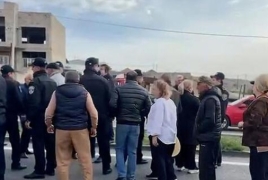
Residents of Proshyan and Kasakh expressed dissatisfaction following a meeting at Armenia’s Ministry of Territorial Administration and Infrastructure.
They demanded the reinstatement of bus routes 25 and 59, which previously served their communities. However, the municipality had already implemented changes before the meeting with Deputy Minister Armen Simonyan.
“We left the meeting very disappointed and will announce our next steps,” said Proshyan resident Sergo Muradyan, as reported by Pastinfo.
During the discussion, residents raised concerns about the newly introduced transport regulations, emphasizing that many travel daily to Yerevan for work or education. They warned that reduced access to transport poses serious social and logistical challenges.
“They just cut it with an axe, saying that’s the law. But laws are written by people—how can the opinions of 20,000 people be ignored?” Muradyan said during the meeting.
Residents demanded that bus route 25 be extended to the entrance of Proshyan, and that route 59 serve the entrance to Kasakh. They stressed that the current arrangements force them to walk along dangerous highways, especially endangering people with disabilities.
In response, Deputy Minister Armen Simonyan stated that under current legislation, these Kotayk Province communities are not part of the Yerevan municipality, and Yerevan’s transport service cannot legally operate there. He noted that interregional buses had been provided, with at least 10% of the fleet adapted for passengers with disabilities. If demand increases, the number of interregional vehicles will rise by 150 units within six months.
However, residents pointed out that the new interregional route terminates at the Physics Institute junction, increasing their financial burden due to additional fares needed to reach central Yerevan.
Simonyan remarked: “It sounds like you expect Yerevan’s transport to enter Proshyan by at least 300 meters so residents can use it. We say: no. Transport will function in the community, and those wanting to use Yerevan’s transit can do so from the nearest endpoint.”
He reiterated that Yerevan’s transport system is legally designated to serve only the capital.
“Why do people from other towns manage with interregional transport despite the same inconveniences? Why can’t Proshyan residents do the same? If they wish, they can also use Yerevan’s transport by walking a short distance,” he added.
Muradyan emphasized that residents now face greater financial strain, especially those commuting from Komitas or Zeytun, given that the new route starts at the Physics Institute.
“The route starts from the Physics Institute. We have sick people commuting from Komitas and Zeytun—they now face a financial burden,” he said.
To this, Simonyan replied: “What do you suggest—that every building in Yerevan have a bus route to Proshyan? I don’t see the logic.”
Muradyan noted that transport prices have already risen to 150 drams, and residents will now have to change multiple vehicles. “People simply can’t afford this. Their situation must be considered,” he said.
The meeting ended with both sides holding their positions without reaching an agreement.
Proshyan residents oppose the cut of route 25 and the introduction of a more expensive alternative. The new service, operated by Multitransport, will charge 200–250 drams and run to the Physics Institute, with the Yerevan–Proshyan route looping near the former Ministry of Defense building. The last bus will depart Yerevan at 19:30. Residents say the price hike and evening access make commuting increasingly difficult.

